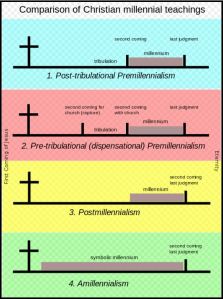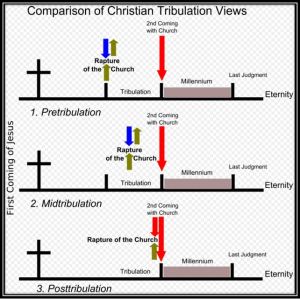Recently I was asked to do a post on the Book of Revelation, a.k.a. the Revelation of John. Since I do not get many requests, in this post I decided to oblige and discuss Revelation. Although I must admit that it is with some trepidation that I do so. Why? This is a very complicated subject, and one that theologians have debated for centuries. Additionally, my own personal understanding of Revelation is not exactly in sync with the larger evangelical thinking today. That said, my intention for this post will NOT be to argue a position in favor of one interpretation over another. Rather, I will simply try and summarize the various perspectives, viewpoints and interpretations of Revelation that are out there — then conclude with my own brief thoughts. So perhaps some my find this post informative.
There are four perspectives on how to view the Book or Revelation. They are the Preterist, Historic, Spiritual and Futurist viewpoints. Below is a brief summary of each:
Preterist View: This view is the belief that most prophecies revealed in Revelation were fulfilled during the age of the Roman Empire. However, there are two different approaches to this view. The first is the belief that the text is not inspired prophecy, but rather a description of historical events coded in apocalyptic imagery. The second is the belief that the text is inspired prophecy, but that most prophecies were fulfilled in the first century after Christ. However, this latter Preterist view still awaits the Second Coming of Christ.
Historic View: This view is the belief that the prophecies of Revelation have been fulfilled throughout history and are still being fulfilled in the world today. Specifically, historicists regard Revelation as a chronology of Church history with historical events symbolically illustrated. This view was popular among Protestants during the Reformation years, as many equated the Papacy with the Antichrist of Revelation.
Spiritual View: This view is the belief that most prophecies in Revelation illustrate the ongoing conflict of spiritual reality and may be fulfilled numerous times throughout history. In other words, it is entirely a symbolic or idealistic approach. This view regards Revelation as the symbolic depiction of lessons and moral-principles that often recur throughout history, i.e. good triumphing over evil or Jesus Christ over Satan.
Futurist View: This view is the belief that most prophecies beyond chapter 3 of Revelation are future events yet to be fulfilled. Futurists tend to believe that few, if any, of the events described in Revelation chapters 4-22 have taken place. This is also the most popular view among dispensationalists. Note, dispensationalists are those who believe God interacts with mankind in different ways through a series of “dispensations” or periods of history.
Of the four perspectives, by far and away the most popular among Christians today is the Futurist View. However, even among this viewpoint there is a wide variety of interpretations. The dominant interpretations are Postmillennialism, Premillennialism and Amillennialism. Note, the millennium refers to the 1,000 year reign of Jesus Christ which then merges with the continuous eternal “new heavens and the new earth” of Revelation 21. Below is a brief summary for each of the Futurist View interpretations:
Postmillennialism: They believe Christ’s second coming will occur AFTER the Millennium, or “Golden Age” in which Christianity prospers. They believe that Jesus already established his kingdom on earth through his redemptive work in the first century, and equipped his Church with the Holy Spirit to make disciples of all nations (The Great Commission). Postmillennialist expect that eventually the vast majority of all will be saved, prior to the second coming of Christ and last judgment.
Premillennialism: They believe Jesus will physically return to earth PRIOR to the Millennium, a literal thousand-year Golden Age of peace. They believe Jesus’ coming to the earth and subsequent reign will come at the end of the apocalyptic period of tribulation mentioned in Revelation 7:14. However, this group can be further divided into Post-tribulation, Mid-tribulation and Pre-tribulation Premillennialist. Those with a Post-tribulation view believe Christ’s second coming will occur after the tribulation. Meanwhile those with a Pre-tribulation view believe Christ will come both before the tribulation, for his Church (in what is called the rapture), and again after the tribulation — with his Church. The Mid-tribulation Premillennialist believe that the “rapture” will occur in the middle of a seven year tribulation.
Amillennialism: They reject the belief that Jesus will have a literal thousand-year physical reign on earth. Instead, this view holds that the thousand years mentioned in Revelation 20 is a symbolic number and has already begun with the formation of the Church. Amillennialist believe Jesus Christ’s reign during the millennium is spiritual in nature, and at the end of the Church age, Christ will return (Second Coming) in final judgment and establish a permanent reign in the new heaven and the new earth.
See charts for visual illustration below (click to enlarge):


By far, the most popular interpretation today is the Pre-tribulation Premillennialist View. Although I should note, this interpretation has only been around since 1827, when J.N. Darby began teaching the concept of a secret “rapture” of the Church in Revelation 4:1. The view was made popular by Evangelist Hal Lindsay in his book on the End Times published in 1970, and has become widespread in evangelical circles due in large part to the popular “Left Behind” book series. This is why it may surprise many believers to learn that the word “rapture” does not actually appear in Revelation at all, or the entire Bible for that matter. It comes from the Latin “rapere” which means “to take up”. The closest scriptural reference is from 1 Thessalonians 4:17, “After that, we who are still alive and are left will be caught up together with them in the clouds to meet the Lord in the air. And so we will be with the Lord forever.” However as noted in my previous post, just because a word is absent from scripture, does not necessarily mean the concept is non-biblical. That said, I myself in this instance do not agree with the belief in Rapture. At least not as it is commonly understood today, i.e. that all believers will disappear, and those left behind will face the tribulation prior to the second coming. Although I certainly believe in a tribulation period, and the second coming of Jesus and final judgment — just not a prelude disappearing rapture event.
So just what exactly is my view of Revelation? This may seem a bit of a copout, but I honestly do not advocate for any one position – although I have my inclinations. As stated from the onset of this post, Revelation is a complex book that theologians have debated for centuries and will continue to do so. To that point, I firmly believe that those who seek to understand it would do well to learn the different perspectives and interpretations – along with the strengths and weaknesses for each view. It often disturbs me to hear many fellow believers claim that their way of interpreting or understanding Revelation is the only valid way. That said, my inclinations on the subject as you might have guessed (and for whatever it’s worth) is that the Futurist View is the correct approach; and I tend to fall somewhere closer to being more or less a Post-tribulation Premillennialist — though maybe not in all the particulars. However I could be wrong, and strongly encourage everyone to study the texts to draw their own conclusions for themselves.
But enough already, time to wrap this post up. In review, there are four major perspectives on how to view Revelation: They are the Preterist, Historic, Spiritual and Futurist viewpoints. The Futurist is currently the dominant viewpoint, which is subdivided into three major interpretations: Postmillennialism, Premillennialism and Amillennialism. However, this is all still a major oversimplification, as I have only scratched the surface in summarizing the various approaches and interpretations to Revelation. The reality is much more nuanced and complicated, as there are many variations and hybrid approaches to these differing perspectives and interpretations. That said, I hope some may have found this post informative and insightful.
Thank you for reading.
JDN

I’ve enjoyed reading your blogs. They are very informative and well researched. I’m curious to know your thoughts on the argument some make, saying hell is not eternal, quoting the second death, mentioned in the book of Revelation?
LikeLike
Thanks for your complement and comments. Concerning your question, I too have heard that interpretation from some: arguing that Hell is not eternal, citing the “second death” of Revelation 20:14. However, there is much more scriptural evidence supporting that it is eternal, i.e. Jesus’ characterization of Hell as a place of “everlasting fire” in Matthew 25:41. As for my own thoughts concerning the second death: I believe the “first death” refers to one’s physical death and separation of the soul from the body; meanwhile the “second death” refers to a spiritual death and separation of the soul from God. The former will be faced by everyone, although it is only a temporary state for believers who will one day be made anew. While the latter is for unbelievers still in their sin, and will be an eternal state (forever). Maybe I’ll post on it sometime. Thanks!
LikeLike